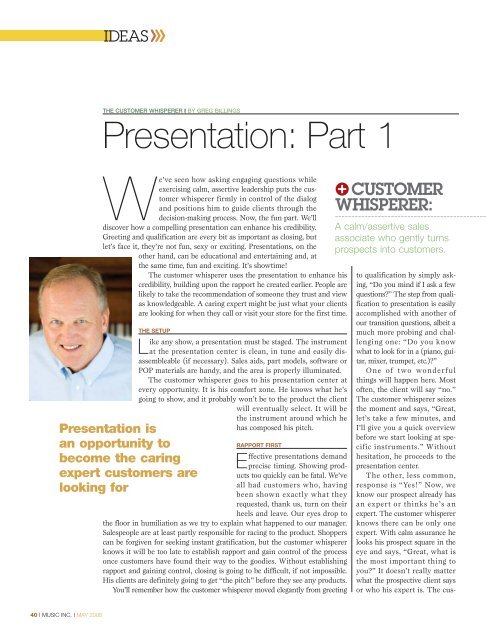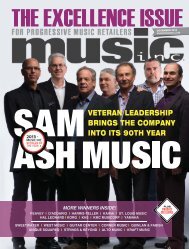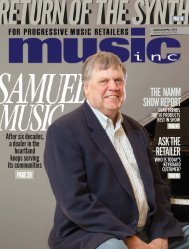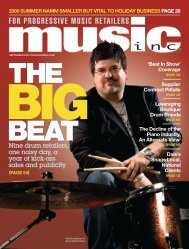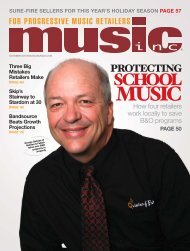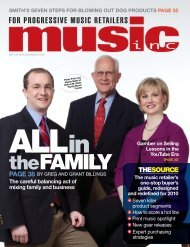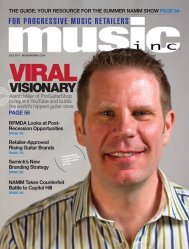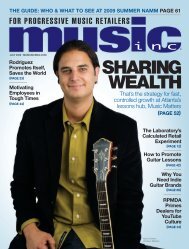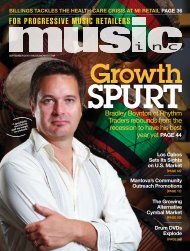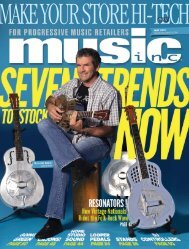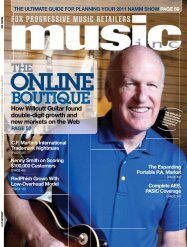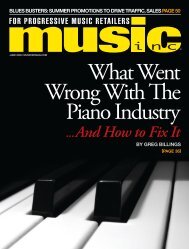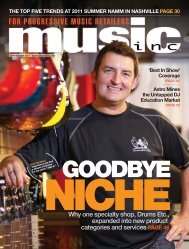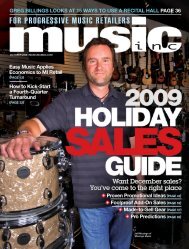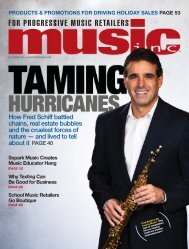download pdf - Music Inc. Magazine
download pdf - Music Inc. Magazine
download pdf - Music Inc. Magazine
Create successful ePaper yourself
Turn your PDF publications into a flip-book with our unique Google optimized e-Paper software.
THE CUSTOMER WHISPERER I BY GREG BILLINGS<br />
Presentation: Part 1<br />
We’ve seen how asking engaging questions while<br />
exercising calm, assertive leadership puts the customer<br />
whisperer firmly in control of the dialog<br />
and positions him to guide clients through the<br />
decision-making process. Now, the fun part. We’ll<br />
discover how a compelling presentation can enhance his credibility.<br />
Greeting and qualification are every bit as important as closing, but<br />
let’s face it, they’re not fun, sexy or exciting. Presentations, on the<br />
other hand, can be educational and entertaining and, at<br />
the same time, fun and exciting. It’s showtime!<br />
The customer whisperer uses the presentation to enhance his<br />
credibility, building upon the rapport he created earlier. People are<br />
likely to take the recommendation of someone they trust and view<br />
as knowledgeable. A caring expert might be just what your clients<br />
are looking for when they call or visit your store for the first time.<br />
THE SETUP<br />
Presentation is<br />
an opportunity to<br />
become the caring<br />
expert customers are<br />
looking for<br />
40 I MUSIC INC. I MAY 2008<br />
Like any show, a presentation must be staged. The instrument<br />
at the presentation center is clean, in tune and easily disassembleable<br />
(if necessary). Sales aids, part models, software or<br />
POP materials are handy, and the area is properly illuminated.<br />
The customer whisperer goes to his presentation center at<br />
every opportunity. It is his comfort zone. He knows what he’s<br />
going to show, and it probably won’t be to the product the client<br />
will eventually select. It will be<br />
the instrument around which he<br />
has composed his pitch.<br />
RAPPORT FIRST<br />
Effective presentations demand<br />
precise timing. Showing products<br />
too quickly can be fatal. We’ve<br />
all had customers who, having<br />
been shown exactly what they<br />
requested, thank us, turn on their<br />
heels and leave. Our eyes drop to<br />
the floor in humiliation as we try to explain what happened to our manager.<br />
Salespeople are at least partly responsible for racing to the product. Shoppers<br />
can be forgiven for seeking instant gratification, but the customer whisperer<br />
knows it will be too late to establish rapport and gain control of the process<br />
once customers have found their way to the goodies. Without establishing<br />
rapport and gaining control, closing is going to be difficult, if not impossible.<br />
His clients are definitely going to get “the pitch” before they see any products.<br />
You’ll remember how the customer whisperer moved elegantly from greeting<br />
b CUSTOMER<br />
WHISPERER:<br />
A calm/assertive sales<br />
associate who gently turns<br />
prospects into customers.<br />
to qualification by simply asking,<br />
“Do you mind if I ask a few<br />
questions?” The step from qualification<br />
to presentation is easily<br />
accomplished with another of<br />
our transition questions, albeit a<br />
much more probing and challenging<br />
one: “Do you know<br />
what to look for in a (piano, guitar,<br />
mixer, trumpet, etc.)?”<br />
One of two wonderful<br />
things will happen here. Most<br />
often, the client will say “no.”<br />
The customer whisperer seizes<br />
the moment and says, “Great,<br />
let’s take a few minutes, and<br />
I’ll give you a quick overview<br />
before we start looking at specific<br />
instruments.” Without<br />
hesitation, he proceeds to the<br />
presentation center.<br />
The other, less common,<br />
response is “Yes!” Now, we<br />
know our prospect already has<br />
an expert or thinks he’s an<br />
expert. The customer whisperer<br />
knows there can be only one<br />
expert. With calm assurance he<br />
looks his prospect square in the<br />
eye and says, “Great, what is<br />
the most important thing to<br />
you?” It doesn’t really matter<br />
what the prospective client says<br />
or who his expert is. The cus-
tomer whisperer will calmly and<br />
assertively up the ante by establishing<br />
doubt.<br />
A real conversation with a<br />
prospect might go like this:<br />
Customer Whisperer:<br />
What is the most important<br />
thing to you?<br />
Prospective Client: A<br />
multi-ply pin plank.<br />
CW: I’m glad to hear that<br />
you’ve focused in on tuning<br />
stability. Nothing sounds good<br />
if it’s out of tune, and you<br />
don’t want to have the tuner<br />
there every other day. Are you<br />
more concerned about the<br />
number of plies, the thickness<br />
of the plies, the curing process<br />
or whether the plies are maple,<br />
beech or a hybrid?<br />
PC: Ugh, what’s a hybrid?<br />
CW: Come over here, and<br />
I’ll show you a few pin plank<br />
samples. It will make a lot of<br />
sense.<br />
Consider the process. First<br />
we agree, next we show sincere<br />
enthusiasm and, finally, we raise<br />
the bar. We are completely nonconfrontational<br />
in our confrontation,<br />
and we have assumed<br />
the position of helpful expert.<br />
At last, we have found our<br />
way to the presentation center.<br />
The process has been slowed<br />
down, and we have our client’s<br />
full attention. Focus has been<br />
diverted from products, and<br />
the customer whisperer is<br />
clearly leading. He’s ready to<br />
start the show.<br />
THE PITCH<br />
It’s not advisable, reasonable or<br />
possible to tell our clients<br />
everything we know about our<br />
product. They don’t have the<br />
capacity or inclination to assimilate<br />
that much information. In<br />
the post-MTV era, we can’t<br />
expect to hold their attention<br />
for more than a few minutes,<br />
and like most people, our clients<br />
are looking for simple answers<br />
to complicated questions.<br />
A generation ago, we were<br />
taught presentations couldn’t last<br />
more than 19 minutes. Today we<br />
have much less time — probably<br />
less than 10 minutes. Our message<br />
must be informative, interesting,<br />
entertaining and focused.<br />
The customer whisperer has<br />
refined, rehearsed and perfected<br />
his pitch until he could recite it<br />
in his sleep. He’s going to let his<br />
passion show, but he’s going to<br />
remain calm. Fortunately, he has<br />
a secret weapon. Unlike other<br />
presenters of other products, he<br />
can employ music’s powerful<br />
emotional impact. He will use<br />
music in short, powerful bursts.<br />
When I was a rep, I had the<br />
opportunity to meet many of the<br />
greatest salespeople of the previous<br />
generation. Invariably, when<br />
I asked about the secret of their<br />
success, they talked about their<br />
presentation. In a strange way,<br />
they all said the same thing.<br />
Whether it was the five features<br />
of a good piano; the three Ts of<br />
tone, touch and tuning stability;<br />
or the eight secrets of Steinway,<br />
* SALE BEGINS *<br />
‘Have your<br />
clients touch<br />
instruments to<br />
feel vibrations.<br />
Have them<br />
push buttons<br />
and turn<br />
knobs.’<br />
there was always a catchy headline<br />
followed by a simple, memorable<br />
(7- to 10-minute) general<br />
explanation of the product that<br />
established their expertise, concluding<br />
with a clever musical<br />
flourish. They did the same pitch<br />
every time they made a presentation.<br />
Over time, it had been<br />
refined and adjusted, but it was<br />
always a sincere effort to communicate<br />
their personal wisdom<br />
in a way clients could easily<br />
understand. Most important, it<br />
established their expertise.<br />
The presumptive customer<br />
whisperer must prepare his<br />
pitch — a general explanation<br />
of the fundamental construction<br />
or technical features of his<br />
product(s) that can be delivered<br />
quickly and confidently in<br />
an engaging, entertaining way.<br />
This pitch must assure his customer<br />
that he knows what he’s<br />
talking about.<br />
Here’s an example: “This is<br />
an electric guitar. It’s comprised<br />
of four parts — a body, a<br />
neck, hardware and electronics.<br />
Here’s how each of these<br />
parts is important, what they<br />
could or should be made of,<br />
and why that is important to<br />
you.” It doesn’t matter what<br />
the product or service is. It<br />
matters that the customer<br />
begins to view the customer<br />
whisperer as knowledgeable.<br />
KEEP IT INTERACTIVE<br />
Veteran sales trainer Gay<br />
Hufstader used to say, “Tell<br />
’em you’re gonna tell ’em. Tell<br />
’em! And tell ’em you told<br />
’em.” Your presentation must<br />
be engaging. Have your clients<br />
b THE SALES PROCESS<br />
The customer whisperer organizes the sales process into nine stages. For those he<br />
has already discussed, we’ve given a brief explanation and the issue of <strong>Music</strong> <strong>Inc</strong>.<br />
they appeared in. Go to musicincmag.com to <strong>download</strong> these articles.<br />
GREETING<br />
Creating<br />
ease and<br />
establishing<br />
control.<br />
(January<br />
2008)<br />
QUALIFICATION<br />
Getting permission<br />
to<br />
ask a few<br />
simple<br />
questions.<br />
(February<br />
2008)<br />
PRESENTATION<br />
Establishing<br />
yourself as<br />
the caring<br />
expert<br />
customers<br />
need.<br />
DEMONSTRATION<br />
OBJECTIONS<br />
[1] [2] [3] [4] [5] [6] [7] [8] [9]<br />
CLOSING<br />
ADD-ONS<br />
REFERRALS<br />
FOLLOW-UP<br />
MAY 2008 I MUSIC INC. I 41<br />
* SALE COMPLETE *
touch instruments to feel vibrations.<br />
Have them push buttons<br />
and turn knobs. Have them<br />
hold products to feel the weight.<br />
The customer whisperer<br />
knows he’s in trouble if he’s<br />
talking and his prospect is passively<br />
listening. He asks confirmation<br />
questions, like “Does<br />
that make sense?” “Doesn’t<br />
that sound great?” “Is that<br />
what you had in mind?” or<br />
“Isn’t that cool?” to keep his<br />
client actively involved in the<br />
process. If clients get accustomed<br />
to saying little “yeses,”<br />
it’s going to be a lot easier for<br />
them to say a big “yes” later on.<br />
Because the pitch is his own<br />
personal wisdom, the customer<br />
whisperer delivers it effortlessly<br />
while he processes what he<br />
learned during qualification. He<br />
will also observe his clients’ reac-<br />
42 I MUSIC INC. I MAY 2008<br />
tions. By the time his 10 minutes<br />
in the spotlight have expired, he<br />
intuitively knows what product<br />
he’s going to demonstrate. As the<br />
pitch ends, his client is interested,<br />
involved and happy to<br />
have met an expert he can trust.<br />
The transition to the demonstration,<br />
where for the first time<br />
we’ll be looking at actual products<br />
to buy, will be accomplished<br />
with another elegantly<br />
simple transition question. The<br />
customer whisperer will say, “I<br />
have something in mind that<br />
might be just right for you.<br />
Would you like to see it?”<br />
Oddly, the customer whisperer<br />
hasn’t done any selling —<br />
yet. He hasn’t taken a position;<br />
he hasn’t endorsed a brand or<br />
made a recommendation. To do<br />
so would undermine his credibility<br />
before his clients have come<br />
b 7 STEPS TO<br />
SUCCESSFUL<br />
PRESENTATION<br />
• Slow down the process. Don’t get there too<br />
soon.<br />
• Get permission. Ask, “Do you know what to<br />
look for...?”<br />
• Go to your presentation center — every time.<br />
• Practice your pitch until it is perfect.<br />
• Keep clients engaged by having them<br />
touch products and by asking conformation<br />
questions.<br />
• Finish with a powerful musical flourish.<br />
• Become their expert.<br />
to view him as a caring expert.<br />
However, during the pitch, he<br />
has planted seeds that will bloom<br />
during the demonstration.<br />
In our next installment, the<br />
selling begins. The customer<br />
whisperer will consider the<br />
proper way to present features<br />
as benefits and the importance<br />
of presenting three choices —<br />
good, better and best. Until then,<br />
start working on your pitch. MI<br />
Greg Billings whispers to customers at the<br />
Steinway Piano Gallery in Bonita Springs, Fla.


